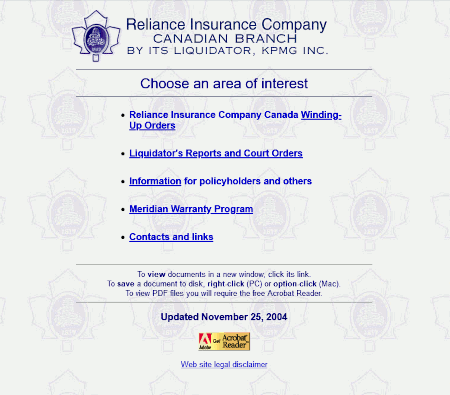The Corporate World
 |
| I spent nearly thirteen years with KPMG Canada. The story of how I “arrived” there is a tale of circumstance. In late 1993, I was being represented by two staffing firms: Graphic Assistants and Olsten. I had learned Microsoft WordBasic (now Visual Basic for Applications, or "VBA"), which led to Olsten calling me in for placement at the internal audit department of the Confederation Life Insurance Company (“Confed”) at 350 Bloor Street East, Toronto. They needed an administrative assistant who could help them migrate their corporate branding, as a merger was being planned. They also needed someone who could handle a newfangled thing called “e-mail” and emulate the workings of the NASDAQ PRISM trading system in Microsoft Excel (I eventually used pivot tables). I fit in quite well with Confed's internal audit staff and began working with its Vice President and Chief Information Officer, Wendy A. Watson. |
 |
|
As time went on at Confed, the prospective merger(s) fell through, and I began being recruited to fax sensitive documents to Ottawa for Wendy. Then, one day (Wednesday, August 10, 1994, to be exact) the internal audit department was in dismay with some in tears: those documents I had been faxing were to the Office of the Superintendent of Financial Institutions (“OSFI”), and Confed was to be seized by a liquidator, KPMG Peat Marwick Thorne (“KPMG”). The next day, August 11, the television and print news were all over the Confed building at One Mount Pleasant Road (“1MP”) …a Canadian institution had fallen. Looking back, I assume Wendy chose me to do her faxing to OSFI (instead of her secretary) because I was my own employee at Confed without any ties to its long-term staff (averting an information leak). Soon thereafter, Wendy asked me if I wanted to cut loose with Confed (it was now defunct) or stick around to see what could happen with my employment. I chose to stay, and Wendy personally recommended me to KPMG’s executive. I was assured by KPMG that the employment contract between Olsten and Confed was severed by the Winding-Up Act (which brought in a liquidator) and Olsten couldn’t demand a buy-out of my services from KPMG or Confed. I was now an independent contractor with KPMG, and I headed down to the Revenue Canada building to register myself as a business and obtain a GST (services tax) number. While my days were spent doing mostly administrative duties like correspondence and PowerPoint presentations, the liquidator and remaining Confed staff needed new Microsoft Word templates for their letters and memoranda, which I designed and macro-coded using VBA. I eventually became involved with KPMG's partners in formatting the elaborate bidder packages which were required to sell-off Confed’s assets. My proficiency with FileMaker Pro had me solely in charge of an extensive “Inventory of Projects” database for KPMG President Robert O. Sanderson, which involved the liquidator's entire team at Confed. My experience with both Macintosh and Windows operating systems allowed me to convert the KPMG executives’ data to (the then new) archival CD-R for a corporate-wide migration to Windows. I introduced the KPMG executive to Adobe Acrobat (then version 2.0) and the use of Optical Character Recognition (“OCR”, using Omnipage Pro) for scanning/digitizing documents. I did everything from huge mail merges to programming the fax machines. Confed’s marketing department had copies of Quark Xpress, which even allowed me to layout KPMG’s press releases and public notices instead of having the liquidation pay for a design firm. |
 |
| A few Confed staff I befriended (namely Lorna Finlay of internal audit) gave me this mug for Christmas in 1995. I had recommended they see PIXAR's "Toy Story" and was using my own copy of PIXAR's "Typestry" product to enhance the PowerPoint presentations I produced for KPMG. That Lorna had PIXAR misspelled as "PIXER" shows how unknown the now famous animation company was at that time. |
| At KPMG's Confed file, I was frequently called-upon to complete tasks that would normally take [too much] time for their Information Technology department to fulfil. I was really in demand and spent many long nights at Confed’s 1MP…sometimes fielding calls from overseas bankers (unsecured creditors) who would call at late hours due to time zone differences. As one of my final tasks at 1MP, I ran off the building’s blueprints in AutoCad for the architects who would extend the structure for the new buyer, Rogers Communications. It was around this time human resources offered me full-time employment with KPMG, but I felt more comfortable remaining a contractor. |
 |
| To boost morale, the remaining Confederation Life staff working for the liquidator at 1MP and elsewhere were given a T-shirt in 1995, which I designed using my own copy of Adobe Illustrator. The T-shirt front is on the left, and the back is on the right. |
With 1MP being sold, the liquidator moved Confed’s operations to York Mills Centre, where I was recruited to operate the liquidation site’s security system (programming employee security cards and perimeter zones). Confed (in liquidation) would be issuing cheques to its primary (secured) creditors, and a database and website would be required. KPMG Vice-President I. George Gutfreund and Partner Edward G. Bossence trusted me to do these jobs, which saved the creditors of Confed the large sum of money an I.T. firm would charge. I used FileMaker Pro and Microsoft Access for Confed’s claimant databases. My databases also produced the cheques which secured and unsecured creditors ultimately received. I completed the Confed website in Adobe PageMill/SiteMill, with FileMaker Pro serving as the HTML database engine using CDML. With my experience using OCR and Acrobat, I was given the responsibility of converting literally thousands of pages of court reports and Orders to PDF viewing for the creditors of Confed to download. This spanned years. The court was pleased that I used OCR to create bookmarked, hyperlinked and indexed document facsimiles, allowing creditors to easily search through even the fine print of every court submission. As the year 1999 approached, I was recruited to be an information technology specialist for KPMG’s Year 2000 Program Management Office (“Y2K PMO”). I was responsible for creating a databased inventory of year 2000 noncompliant software used by KPMG Canada and its suppliers. I used FileMaker Pro yet again to have our databases available to KPMG employees across its national IntraWeb. Believe it or not, the Y2K bug *was* an issue: but it was also a no-win situation. If we addressed the bugs (which we did) there would be no problem and people would think Y2K was a hoax…if we failed to address the bugs, we would then get blamed for not doing our jobs. I spent the better part of a year at the Y2K PMO, while working on the side with the KPMG executive in Commerce Court West, Toronto. |
 |
| After years at York Mills Centre and Commerce Court, I informed KPMG that I wanted out of my almost full-time administrative role and to be contracted for I.T. issues only. In 2001, I was called onto the Confed liquidation’s new site at 800 Bay Street for another liquidation: Reliance Insurance Company (“Reliance”, Canadian Branch). Being a sole contractor, I was a very economical I.T. solution and had provided professional results with Confed — then the largest insurance liquidation in North American history. For Reliance, I used FileMaker Pro for the claimant database and Macromedia Dreamweaver for the web site. Like Confed, Reliance required new templates and its court reports and Orders converted via OCR into indexed and searchable PDF downloads. Reliance and the ongoing Confed file kept me going for years until my final project at KPMG rolled around: the failed hedge funds of Portus Alternative Asset Management Inc. (“Portus”). |
 |
| My website for Reliance Insurance (Canadian Branch) which, like Confed's website, was graphically bare bones to reflect a liquidation. |
| Portus was a very high-profile file which made news across North America in 2005 when it was placed into receivership (not liquidation) by the Ontario Securities Commission (“OSC”). The RCMP were also involved in the criminal proceedings, along with KPMG. I had to jump through a few hoops (like making a bid) before I was able to work on the file: which was located at both the former Portus offices at BCE Place and KPMG’s new setup at King and Yonge Streets. My first role was getting a website online, which now had to conform to KPMG Inc.’s new online style guide. The website also required CGI functionality and scripts, so I had to teach myself something new. I also ran thousands of pages of court submissions through OCR to render them searchable, indexed and of a small PDF download size for investors accessing by dial-up modem. |
 |
| My website for the Portus receivership/bankruptcy, which I designed and coded to adhere to a new KPMG Inc. online style guide. |
| When it came time for Portus’ investor and claimant database in 2006, I was awarded the contract. This time, I was using FileMaker Pro Advanced and Server Advanced to help the KPMG I.T. department set-up an office space for 20-plus data entry staff to handle the claims entry duties for Portus’ over 26,000 investors. The database entry went off without a hitch and I was, again, saving the investors the cost of an I.T. firm handling a huge undertaking like Portus. The security at the Portus file was high, and I had to have my USB key and backup CD-R examined by KPMG staff whenever I needed them to support the file. Around this time, I was also involved in creating an online/database solution for KPMG's human resources department called "KHire", which didn't get far past the demo phase. I was also heavily involved with NOW Communications (Toronto's popular NOW Magazine) in creating a FileMaker Pro solution for their print and online listings, which took-up all my free time. As the months went by, I noticed that my mental health was deteriorating. By 2007, I had trouble sleeping, felt paranoid and began making mistakes on the Portus file. I was nearing the point where the Portus database required advanced functionality, when I detected that I was entering psychosis. I knew I was becoming a liability to KPMG and the Portus file, and I sent my resignation to V.P. George Gutfreund via a March 28, 2007, e-mail. My resignation was met with hesitation, but it must have been apparent that I was losing my faculties. I assured George that it was a good time for me to leave, since the Portus database was at a nascent phase. I
gave my
contractually determined two-weeks notice and spent most of that time
creating manuals for the Confed, Reliance and Portus databases so that
another firm could take care of my duties. Despite taking care of KPMG’s
needs as best I could in failing health, I still feel like I let down
Mr. Gutfreund in particular, since he trusted me to handle a high-profile
project like Portus. Handing-off my database duties to a firm (who
interviewed me before I left) must have cost a fortune. My last day
with KPMG was April 13, 2007.
All-in-all, I feel grateful for having so many responsibilities given
to me by such a high-profile international firm like KPMG. I had made
it from Whitney Pier, Cape Breton Island, to King and Bay Streets in
Toronto with only my skills and knowledge to propel me. It was never
boring. |

|
| My farewell gift to A. Colin Rogers, Partner of KPMG, which we had framed to memorialize his writing of so many letters to Confed's unsecured creditors from 1995-1997. I rendered the letters in Adobe Dimensions, with the rest of the photomontage being handled in Adobe Photoshop. Colin gifted me a Birks desk clock as a thank you. |